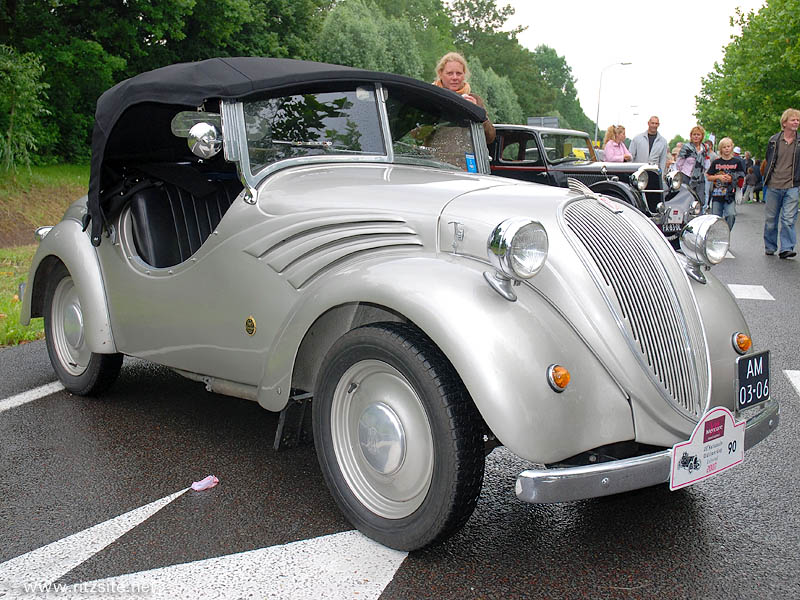|

NSU-Fiat 500 - Spider-Sport body by Glaser - manufactured in 1938
Anyone interested in cars knows that Fiat is an Italian manufacturer; less familiar is the fact that there were Fiat factories in a number of other European countries. Best known example of that is probably the Spanish Seat company which used to produce Fiat models from 1953 till the end of the 1970s. But Fiat production outside of Italy had already started a long time before that. In Germany for instance Fiat founded an sales and assembly organization in 1922. Successful sales inspired Fiat to expand their efforts in Germany and in 1929 a deal was struck with the floundering NSU company. Fiat took over the new factory in Heilbronn which NSU had erected just a few years before and resumed NSU car production under the NSU-Fiat name. Obviously the hard to sell NSU designs were phased out rapidly and replaced with popular Fiat models which were now produced locally.
NSU, based in Neckarsulm and dating back to 1873, continued separately but had to give up car production as part of the deal. They only did so hesitantly in 1933 and all ties with NSU-Fiat in Heilbronn were severed. The original NSU factory continued with bicycles and motorcycles, apart from some prototype cars. Still the two NSU companies caused plenty of confusion on the vehicle market in the following years, culminating in lawsuits when the original NSU company returned to the luxury car market with the Prinz model in 1957. Ultimately NSU-Fiat replaced its brand name with Neckar in 1966 to put an end to the confusion.
From the start Fiat models produced in Heilbron were practically identical to their Italian counterparts, though some of the model names differed: for instance the 508 Balilla became the NSU-Fiat 1000 and the 508 C was named the 1100. While many technical components were still made in Italy the bodywork was often provided by external German coachbuilders like Weinsberg, Drauz and Glaser. This lead to a number of body styles which were specific for the German market and not offered by Fiat in Italy. Most successful pre-war Fiat model in Germany was the 500. This innovative little car dubbed "Topolino" (mouse) in Italy appeared on the German market in 1937 and immediately sold in thousands.
Also the NSU-Fiat 500 model was offered in a few specific German variants. As Germany was gearing up for war metal came at a premium so an attempt was made to reduce the price of the 500 by providing a body made of wood covered with imitation leather as an option. It was made by coachbuilder Weinsberg and it followed the original lines of the Topolino apart from a fold-down roof option. The limitations of the used materials resulted in a less convincing look and, more importantly, reduced durability. A very different German variant was the Spider-Sport model. It was a pretty 2-seater roadster with a steel body on a wooden frame. Prototypes of this model were made in 1938 by coachbuilder Glaser and an example of that is shown above. In 1939 the production model became available but now the bodies were made by Weinsberg, with an identical design.
NSU-Fiat made about 5000 units of the 500 model before the war ended production in 1941. The Spider-Sport model, priced only slightly higher than the steel version of the regular 500, was made only 300 times. Just a handful of the Spider-Sport prototypes were made by Glaser, which makes the car shown here almost unique.
NSU-Fiat resumed luxury car production in 1952 with the 500 C. In the following years a wide range of Fiat models was produced in Heilbron and also some unique models. The name change to Neckar in 1966 lasted only to 1969, after that regular Fiat badges were used on the Heilbron cars. In 1973 all assembly and production activities in Germany were terminated by Fiat; by then it was more economical to import complete cars.
Some 40 years of German Fiat production was rapidly forgotten and nowadays it almost seems unlikely that there was a time when the proverbial German thoroughness also applied to these temperamental Italian cars. But even in the nooks and crannies of automotive history there are little gems to be found, as the car shown here proves.
© André Ritzinger, Amsterdam, Holland
|
